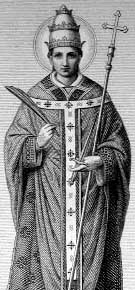
Alexander I was Pope from c. 107 to c. 115. St. Alexander was a Roman and is said to have been a student of Pliny the Younger. Little is known about Alexander, although legends say that he converted his jailer, St. Quirinus, and his daughter, St. Balbina. Alexander is also supposed to have introduced the custom of blessing houses with salt and water, although modern scholars say this is a pagan custom. He is also supposed to have introduced the commemoration of the Last Supper into the mass, although scholars say this is an anachronism. The story that he was beheaded under Trajan or Hadrian is thought to be a confused with a martyr named Alexander.
6th Pope of the Catholic Church from c. 107 to c. 115Pope Alexander I (died c. 115) was the sixth Bishop of Rome from c. 107 to his death c. 115. The Holy See's Annuario Pontificio (2012) identifies him as a Roman who reigned from 108 or 109 to 116 or 119. Some believe he suffered martyrdom under the Roman Emperor Trajan or Hadrian.
Life and legend
According to the Liber Pontificalis, it was Alexander I who inserted the narration of the Last Supper (the Qui pridie) into the liturgy of the Mass. However, the article on Saint Alexander I in the 1907 Catholic Encyclopedia, written by Thomas Shahan, judges this tradition to be inaccurate, a view shared by both Catholic and non-Catholic experts. It is viewed as a product of the agenda of Liber Pontificalis—this section of the book was probably written in the late 5th century—to show an ancient pattern of the earliest bishops of Rome ruling the church by papal decree.
The introduction of the customs of using blessed water mixed with salt for the purification of Christian homes from evil influences, as well as that of mixing water with the sacramental wine, are attributed to Pope Alexander I. Some sources consider these attributions unlikely. It is certainly possible, however, that Alexander played an important part in the early development of the Church of Rome's emerging liturgical and administrative traditions.
A later tradition holds that in the reign of Hadrian, Alexander I converted the Roman governor Hermes by miraculous means, together with his entire household of 1,500 people. Quirinus of Neuss, who was Alexander's supposed jailer, and Quirinus' daughter Balbina of Rome were also among his converts.
Alexander is said to have seen a vision of the infant Jesus. His remains are said to have been transferred to Freising in Bavaria, Germany in AD 834.
Supposed identification with a martyr
 Eighth-century fresco of Saint Pope Alexander I from Santa Maria Antiqua
Eighth-century fresco of Saint Pope Alexander I from Santa Maria Antiqua
Some editions of the Roman Missal identified with Pope Alexander I with the Alexander that they give as commemorated, together with Eventius and Theodulus (who were supposed to be priests of his), on 3 May. See, for instance, the General Roman Calendar of 1954. But nothing is known of these three saints other than their names, together with the fact that they were martyred and were buried at the seventh milestone of the Via Nomentana on 3 May of some year. For this reason, the Pope John XXIII's 1960 revision of the calendar returned to the presentation that was in the 1570 Tridentine Calendar of the three saints as simply "Saints Alexander, Eventius and Theodulus Martyrs" with no suggestion that any of them was a pope. The Roman Martyrology lists them as Eventius, Alexander and Theodulus, the order in which their names are given in historical documents.





